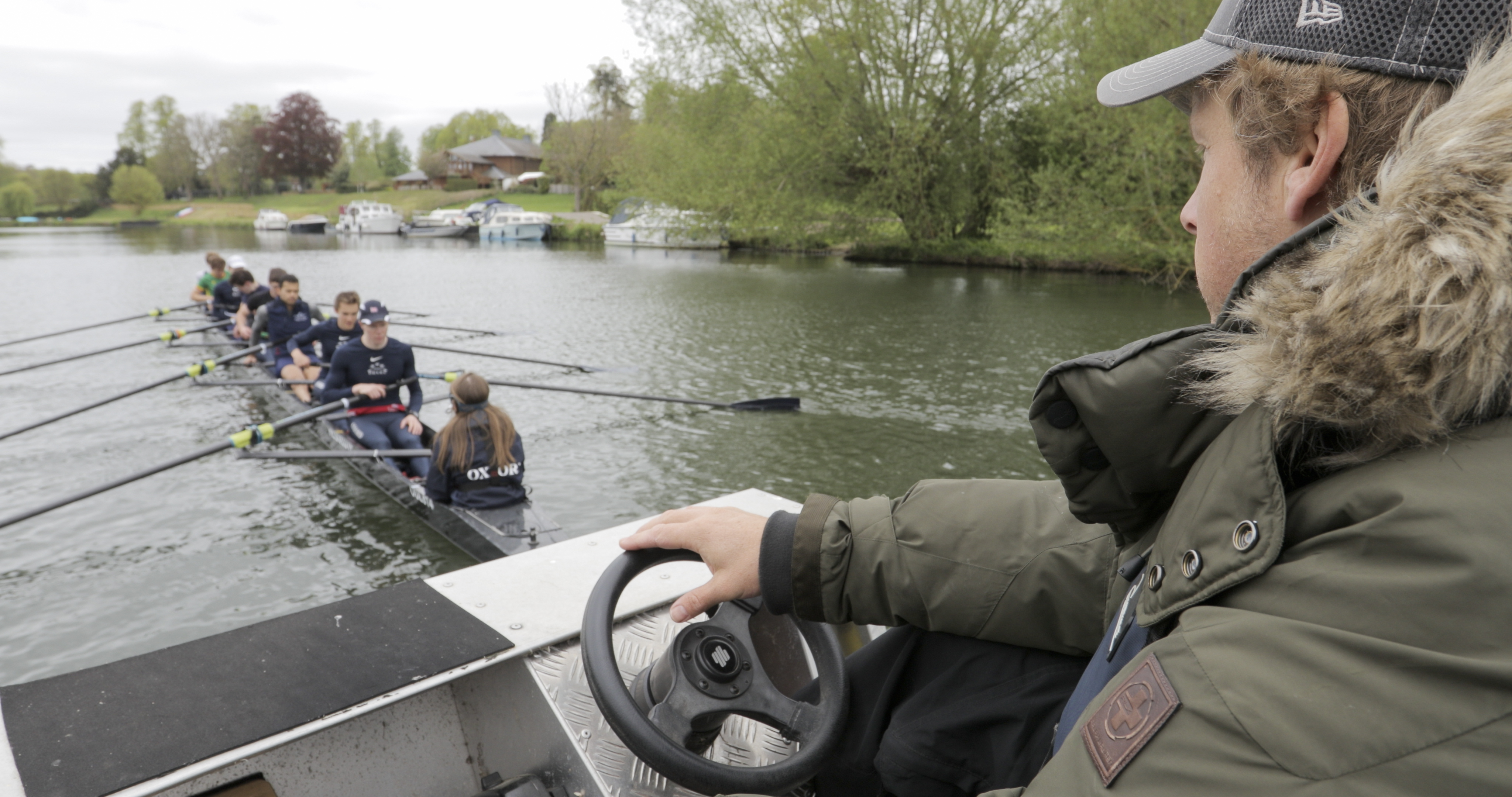The cox’s number one job is to keep their crew safe! Alongside the steering and safety, my job is to make calls that direct the crew members to row in sync, to improve their technique and guide them through a race.
Get inside knowledge on how to become a better coxswain…
I don’t really remember a time in my life where I haven’t had or known rowing. I began to fall in love with the sport at 9 years old on the riverbank of the Thames in Staines. Even before then I was taken as just a bump to Henley Regatta riverbanks. Now, I must try and make a day in my week that doesn’t involve it! I began rowing at 11 years old and dragged my dad back into it with me.
We have both had an amazing journey with rowing albeit very different. He now coaches and I now cox. I transitioned to coxing from rowing when I was around 20, I attended trials for a number of years before gaining selection for Great Britain. Why? Because rowing is in my bones, blood and brain and I can’t escape it, but also because there is no better feeling than being on a lake or river with only the noise of the blades, the boat and nature (and I guess my voice)!!
What does a coxswain do in rowing?
At international level there is only one seat for a cox on the men’s team and one on the women’s team, that is in the eight. At club level there are seats for coxes in fours and eights and at the younger age groups quads and octuples.
The cox ultimately bridges the gap between athlete and coach. I often find myself listening more than talking, taking on board how the athletes are, what they are feeling, what they want in the boat and the same from the coach. I’ll come back later to cover a little more about coxing off the water.
Is there a minimum coxswain weight for rowing? Well, we would usually try to race at a minimum of 55kg (at senior level). This weight tends to make the cox one of the smallest members of the team, the job however, does not reflect this! At any one time I may find myself juggling many balls, a little like a formula 1 driver, a jockey or an American football quarterback. During a training session a good cox will be steering, coaching technical points, guiding the synchronisation of the rowing, monitoring and feeding back the speed and rate the crew are at, listening in to the coach and re-emphasising their coaching points, feeling for the technical changes the crew are making and the impact that is having on the hull and communicating with the rowers, especially the person sitting at stroke. This changes slightly during a race and the roles here would be steering, feeling for technical aspects that could improve the boat speed and making these technical calls, motivating, monitoring and feeding back on speed and rate, monitoring and feeding back on the crews’ race position, following or adapting a race plan and telling the crew the distances they have left.
Coxswain Rowing Calls
Key elements:
- Tone & sound
This can be varied throughout to reflect the effort and flow of the crew. - Language
This must be developed with the crew and coach to mean the same to everyone. - Volume
This is similar to the tone and sound and should reflect what the crew require. - Technical
A good understanding of the rowing technique is crucial to developing calls. - Motivational
This can be done in many ways, through language, psyche, tone, volume, but it is the knowing of when to use drive and when to use reward that is key. - Tactical
This comes from the timing of the call but also from knowing the course, the conditions and the crew. - Use of silence
One of the most underrated tools of a cox, using silence when necessary but also to create impact of the most important calls. Let the calls land!
For me, knowing what you want the outcome of the call to be is crucial. As you head down a race track you want to be able to tweak the pattern the rowers are rowing, edging it to be the best it can be in order to get the boat speed to its maximum. In order to tweak effectively, it must be kept simple and clear for the rowers to have the best chance of responding together and that is where timing becomes imperative.
In the race plan you and your crew will likely select 3 technical points to focus on. If one of those points was to lead with the legs and hang then the calls may go as follows; “1:28 split, let’s push to 1:27 with the legs first…(silence for a couple of strokes where you monitor the change then feedback)…YES, legs are good now 1:27, hold…(quiet again for a short period of time to monitor if it is held)…rock solid on the split. This is good”.
What do the best coxes do…
- Avoid using ‘filler’ words, where a word or phrase is repeated without any purpose, they have the composure to leave silence in these moments.
- Make their calls direct and clear, ensuring they don’t leave too much space between the point and the instruction i.e. legs, ready, go.
- Provide clarity to the crew on how they will make changes. “Push away from ‘X’ by getting hips up and over, now”.
- Organise their calls to keep them simple and always keep their head in the present allowing them to update the crew on position.
Coaching a Coxswain
When coaching a cox remember that it is as important as coaching an athlete. We as the cox, are someone that can assist in getting your message across to the whole crew in the best way, allowing them all to respond in unity. As the coach, it is your role to help us think for ourselves using a technical model that suits the crew and you. For both the coach and the cox it is an art of working together, we may not always agree but it is important that both the coach and cox’s respect from the athletes isn’t affected. In every high functioning successful team is one key element and that is trust.
Without trust a good team will never be able to reach its full potential and this in coxing is crucial, the athletes must be able to believe wholly in everything that is said. As a coach you can facilitate the building of this trust, supporting the cox to increase their understanding. One of the biggest learnings for any cox or athlete will be to understand their mistakes, not be punished for them but to be assisted in learning to take responsibility for them so they only happen once. Only a good coach will be able to help them use these mistakes as opportunities.
Coxing off the water
We are often found doing our own training to stay fit, strong and make weight, I will be found running, cycling or doing yoga. Coxes will also coach the athletes, on the bike or in the launch, improving their technical eye and skills. Our role as a cox can be a bit of a lonely one, in between an athlete and a coach, always toeing the line between being professional and personal, reassuring or challenging as appropriate. I find this particularly challenging during an on-water assessment for the rowers.
At any boat club you can often stumble across a cox ‘hanging out’ with the boats! Tinkering with the set ups of; the blades, foot stretcher positions, rigger positions and seat types as the athletes move between different boats and different seats. Yes, the coaches will often get involved in this too but it is a major part of the coxing job.
Pre-race routine for a coxswain
For me, ‘tinkering’ is also part of my pre-race routine. Whilst the athletes are warming up and focusing their minds, I must do the same. Before a race you will always find me with my coach checking that everything is tight on the boat, and it is ready to race. I find this cathartic and calming, keeping my hands busy and giving myself something to focus on whilst I run calmly through the plan, a form of visualisation. I will first focus on the warm up, how it fits into the warm up lake space and the timings of each element. This is important so I know exactly where to put each aspect and build in faff time and leeway for other crews.
The warm-up should be about priming the athletes in the best way before we get to the start line where we MUST arrive on time. I run through what I may say on the start line to the crew and then I run through the race plan. I often find I am interrupted throughout this process, but I like this, it adds reality to the situation. When you are out on the water you have hundreds of interruptions such as, a gust of wind coming in, where the other crews are, how is it feeling, it has or hasn’t gone to plan, an aeroplane goes over, the start is delayed etc. So why not prepare for that on land, conversations with other athletes, with athletes in my crew, with the coaches, watching of other races, emotions, nerves. It’s all there and it’s the best way to get right into what is important.
Is there a difference between coxing at club level vs elite level?
I don’t believe the role of a cox changes much at each level. All the above principles still apply. The key thing that runs through coxing at any level is the reason behind why the cox is there. Although this reason will differ from cox to cox, it is going to be for the community, the friendships, the love of the sport because let’s face it, even at an elite level it’s not for the money! My coach from University of London said to me the simple answer is “at club level you are teaching and at elite level you are coaching.”
I think this is very accurate and although it is simple, it is the best way I could come up with to describe the difference. The job role is still the same, just as big and fulfilling, the framing of what you are saying on the water is just adjusted to better suit your audience.
Summary and conclusion
As a cox I have been referred to as ‘the real boss’, ‘the eyes and ears’, ‘the brains’ but ultimately I am the person that holds the role to bring together the 8 people in front of me and my coach. I am the person that steers the boat straight, that guides, that directs, that drives the crew on, with my voice. So, I guess I really am the brains of the power I drive!
References
https://www.row2k.com/features/379/Coxswain-Calls/
https://washingtonrowing.com/makes-great-coxswain/
https://www.nfhs.org/articles/the-importance-of-a-strong-coach-athlete-relationship/
https://worldrowing.com/2021/11/12/in-the-head-of-a-coxswain/
View more content like this

Rowing Chat Interview with Adrian Cassidy on Data in Rowing and New Ludum Features
Ludum CEO Adrian Cassidy speaks with Rebecca from Rowing Chat on how Ludum helps coaches and athletes, exciting new Ludum features, the importance of data
Determining a relevant training load score in rowing
Training load is an emerging topic for those serious about training. We have come to the limits of how much time people can train (and
Length, Force, Stroke rate – Which is your Strength?
Is it better to be more technical, stronger? How much more power do you need to deliver if you row shorter? Is it realistic to



